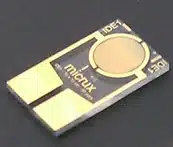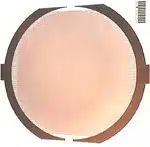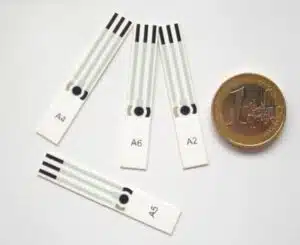Screen Printed and Film Electrodes
Screen-printed and Film Electrodes make electrochemical detection very interesting for analysis in everyday life, especially point-of-care measurements. The measuring devices as well as electrodes can be miniaturized, making them portable. The results are quantitative and, when produced in large quantities, electronics get very cheap.
Commercial biosensors
However, a product made for usage by people who have no electrochemical education must do away with all the demanding preparation and cleaning steps involved in reusing an electrode. This is why in recent years disposable test sensors have become increasingly important. A gold disc in a Teflon coat is too expensive for a disposable sensor. Another group of electrodes is more suitable for this objective.
Flat electrodes that are deposited on a surface are the up-to-date commercial biosensors. These are again divided into two groups: film electrodes and printed electrodes.
Film Electrodes

Film electrodes are made by metal deposition on a surface that is covered with some kind of mask. The mask only exposes the parts of the metal that should be filled with metal afterwards. The metals are deposited by heating up the metal source in a vacuum while the masked sample is present. If different metals need to be on the same sensor, for example when a gold WE and a silver RE are requested, different masks and cleaning processes need to applied to ensure that the gold and silver will not be deposited on the same surface. As a consequence most sensors produced this way have WE, CE, and RE from the same metal.

The advantage of these electrodes is that the masks are created by photolithography and very small structures can be created. For example, DNA chips with dozens of working electrodes in a 1 mm² or interdigitated electrodes can be produced. Interdigitated electrodes are always pairs. Each electrode looks like a comb and they are arranged in such a way that each tooth is between two teeth of the other electrode. With this setup species are cycling between the two electrodes and this behavior creates an amplification of the signal.
Figures 1, 2 and 3 show some examples of film electrodes.

Screen Printed Electrodes
The main difference with screen printed electrodes (SPEs) is the material the electrodes are made of. While film electrodes are made from pure metals, screen printing uses pastes or inks to create a sensor. A mesh with a mask is placed above the empty support, a polyester sheet for example, without touching the support. The ink is put on the mesh and a squeegee is moved across the mesh to press the paste through the template as well as to create contact between the mesh and the support. The paste remains on the support. A drying step follows. The drying step can include heating, especially for water based inks. Each different paste also needs a different mask, same as with the thin film methods, but since no vacuum is necessary the price for the needed equipment is lower and depending on the drying step the procedure can be faster.
The inks usually contain the conducting material, for example the metal particles or carbon compounds, some dispersion agents as well as other additives, polymer binders and the solvents. For the results, the ingredients and their ratios are very important. The results are usually rougher and have lower conductivity than classic electrodes, but the production is cheaper, especially in mass production. Due to the fact that it is easier to use different materials than while producing film electrodes, screen printed electrodes have often WE, RE, and CE made from different pastes.
Counter electrodes are made of carbon pastes, because they are cheaper than metal pastes. Reference electrodes can be made of silver paste mixed with silver chloride, so that a stable reference electrode is achieved.

The price per piece for a film or screen printed electrode decreases with the number of produced electrodes, due to the fact that the most expensive parts are the masks that only need to be produced once. The low price allows these electrodes to be produced as a one-time use or disposable electrode. As a consequence any steps for cleaning the electrode after a measurement can be skipped, because the electrode is disposed of. If the electrode has a dedicated application, most preparations can already be done by the producer.
All this makes it possible to develop electrochemical applications that can be operated by people with no background in electrochemistry. The best example is the blood sugar measurement, which is used by diabetes patients.
Our selection of screen printed and film electrodes can be found here.
